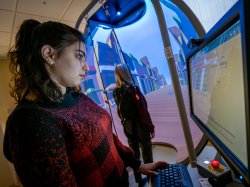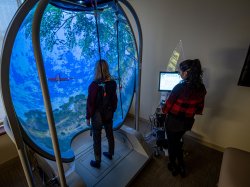Balancing Audiology and Exercise Science Needs
Montclair State University’s Audiology Clinic leverages cutting-edge virtual reality tool for enhanced balance assessment and research
Posted in: College for Community Health, Health, Homepage News, Research, Science and Technology, University

Thanks to a one-of-a-kind virtual reality system used to evaluate gait and balance disorders and assess fall risk among clients served by Montclair State University’s Audiology Clinic, students have another tool to use in their studies and doctoral research.
A third-year Audiology student, Max St. Germain is among the first to conduct research using the Bertec CDP Virtual Reality Balance System and a phone app to assess fall risk. As anticipated, he determined that the system, which measures center mass by having people stand on plates before a large screen with different scenes in order to measure how much they sway during different exercises, was more sensitive than the phone app. He was testing the app because it can be more accessible to small practices where space and funding may be an issue. “The phone app has some degree of success, but obviously doesn’t work as well,” he says. “If the phone could be used, then clinicians with limited resources to balance equipment could just use a phone.” He also found that the system and app measure different forms of balance and therefore more testing is required.

An Army National Guardsman and former EMT, St. Germain decided to pursue a career in audiology after taking a course taught by an audiologist. He found he wanted to do less emergency medical care. “I really liked the work that he did and it seemed like a rewarding career,” he says. “You get to help people, and you’re not necessarily dealing with critical patients.”
St. Germain, who is also a teaching assistant and taught second-year audiology students Natalie Niyazov and Kristen Nortwich how to use the system, is glad to have it as a tool. “It’s neat we get to have this because I don’t think any other schools do,” he says. “It’s a nice perk for this program.”
The one-of-a-kind system is used to evaluate gait and balance disorders, as well as provide rehabilitative strategies, says Audiology Clinic Director Faith Mogila. It has been used as part of a diagnostics course and lab in which Niyazov and Nortwich participated. Both are former speech pathology students who switched to audiology.
With several relatives who have hearing issues, Niyazov says, “I have a lot of exposure, literally, so, luckily I was able to fall into audiology.”
Nortwich says she wanted to do something in the medical field. She and her family “are happy that I went into a field that helps people.”

That Montclair has the equipment is indeed a plus, as it is more typically found in hospitals and physical therapy practices. “There’s a rehabilitative aspect of it,” Mogila says. “You don’t find them in audiology doctoral programs because there’s a space issue and significant cost issue.” Montclair’s system, the only university-based system in the area, is one of only four on the East Coast; the others are at New York hospitals.
Mogila made a case for the equipment, which was approved a couple of years ago. After some assembly, needed repairs and training, the $200,000 system was put to use. While the Audiology Clinic funded some of the purchase, “we would not have been able to purchase it without the provost funds,” Mogila says.
The Bertec system and students’ work allowed for collaboration between the Audiology and Exercise Science departments, now both part of the College for Community Health.
“When people think audiology, they don’t always think balance disorders and who would have known that we have this,” Mogila says.
Exercise Science and Physical Education Assistant Professor Luis Torres is on the committee reviewing St. Germain’s research project and says he appreciates the collaborative spirit between his department and that of Communication Sciences and Disorders. “The familiarity with different types of balance testing was what allowed me to join the committee and help students,” Torres says, noting that athletic trainers, physical therapists, occupational therapists and other rehabilitative professionals can all benefit from understanding balance testing. “In the physical rehabilitation world, we use the information gathered from balance tests to help us identify risks for falling and reinjury within our rehabilitation programs.” Torres, whose research centers on mental health in physical activity and improving concussion care, says the findings also could help when dealing with athletes or more active people “make decisions on return to play or return to activity.”


Mogila says the collaboration has been an asset to audiology students, such as St. Germain. “When Luis came onboard, he had all these tools in his toolbox that I wouldn’t have thought of, so, it made it a really multidisciplinary project,” she says. “Together, we were able to put collaborative insight into the projects which proved very successful.” In addition, such collaboration also benefits the College for Community Health by embodying the mission of working together, she adds, noting that “there’s a lot of potential projects with this” system. Torres envisions using it for future faculty projects, as well.
For students like St. Germain, Torres says, it allows them to showcase an “interdisciplinary experience in audiology and through a lens outside of audiology” as well. “That’s probably the best thing we can offer them: To help them get great jobs that they love.”

Story by Staff Writer Sylvia A. Martinez. Photos by University Photographer Mike Peters.
